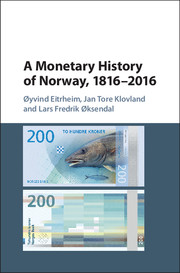Book contents
- Frontmatter
- Contents
- List of Figures
- List of Tables
- Preface
- 1 A Monetary History in Five Parts
- PART I THE LONG PROMISE, 1816–1850
- 2 What Came Before: Dano-Norwegian Experience, Monetary Upheaval and a New Bank of Issue
- 3 The Birth of Norges Bank and the Thorny Road to Resumption
- PART II THE RISE OF PRIVATE DEPOSIT-TAKING BANKS, 1850–1914
- PART III WORLDWAR I AND TURBULENT INTERWAR YEARS, 1914–1940
- PART IV MONEY IN TIMES OFWAR, CENTRAL PLANNING AND REGULATION, 1940–1986
- PART V THE LONG RETURN, 1986–2016
- Bibliography
- Index
3 - The Birth of Norges Bank and the Thorny Road to Resumption
from PART I - THE LONG PROMISE, 1816–1850
Published online by Cambridge University Press: 09 February 2017
- Frontmatter
- Contents
- List of Figures
- List of Tables
- Preface
- 1 A Monetary History in Five Parts
- PART I THE LONG PROMISE, 1816–1850
- 2 What Came Before: Dano-Norwegian Experience, Monetary Upheaval and a New Bank of Issue
- 3 The Birth of Norges Bank and the Thorny Road to Resumption
- PART II THE RISE OF PRIVATE DEPOSIT-TAKING BANKS, 1850–1914
- PART III WORLDWAR I AND TURBULENT INTERWAR YEARS, 1914–1940
- PART IV MONEY IN TIMES OFWAR, CENTRAL PLANNING AND REGULATION, 1940–1986
- PART V THE LONG RETURN, 1986–2016
- Bibliography
- Index
Summary
Introduction
This chapter analyses in broad terms how the monetary restoration was carried out and eventually materialised in the form of a stable currency and an embryonic monetary system that served the needs of the economy. The centre stage of the chapter is occupied with the thorny road to resumption. The legislation introduced in 1816 laid down a principle, that the note issue should be backed by specie and that notes should be freely convertible into silver. From the beginning this was a weak pledge, a commitment for the future. The year set for the resumption of specie payments, 1819, passed without Norges Bank being anywhere near the objective. In 1822, a course was adopted where Norges Bank started paying out in silver, but at a discount for the note holders. Gradually the premium commanded by silver was reduced, bringing the value of notes closer and closer to their promised par value in silver. Although far from their ultimate target, this change of course in effect promoted monetary stability by securing a lower limit below which the exchange rate, i.e. the silver value of the bank notes, would not depreciate. Resumption took time. Not until 1842 did the weak pledge finally materialise in the tangible conversion of one speciedaler note into one speciedaler silver coin.
That resumption would take more than twenty years reflected the fact that monetary restoration was not only a question of monetary stability. In essence, Norway was in strong need of a well-functionin gmonetary system. An early move to specie payments might have jeopardised the vital role Norges Bank had in supplying credit and means of payments. As the case is today, monetary authorities of the past had to balance different and at times conflicting objectives. In this case, taking time provided the answer. Over these years the Norwegian economy grew into its monetary coat. This chapter also describes the fiscal prudence of Norwegian governments after 1814 and provides a brief comparison of the Scandinavian countries’ divergent roads to resumption.
In the final section of the chapter we take a closer look at the early credit market in Norway and the role of Norges Bank in the credit economy. From the beginning Norges Bank was the only institutional provider of credit in the country and would remain in a dominant position throughout the period in question.
- Type
- Chapter
- Information
- A Monetary History of Norway, 1816–2016 , pp. 83 - 112Publisher: Cambridge University PressPrint publication year: 2016
- 5
- Cited by

